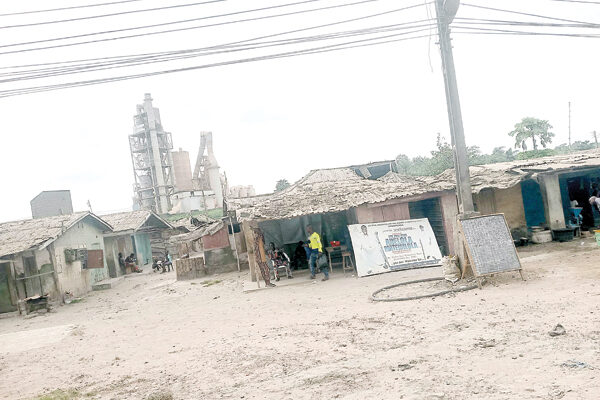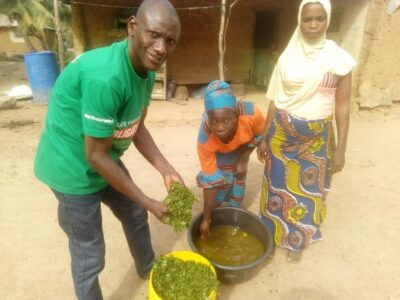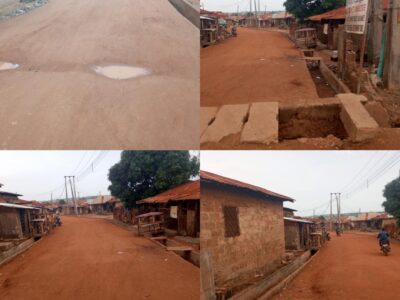Year in, year out, residents of Ewekoro and its environs continue to groan over the effect of dust pollution from cement production on their livelihood. Many have been forced to abandon their homes while those who chose to stay are devising different ways of coping with the phenomenon. MICHAEL BABATUNDE writes on how residents of the area cope and the risk they put themselves in just by still residing in the area.
FOR years, residents of Ewekoro and neighbouring villages have been embroiled in an unending battle with air pollution occasioned by activities of cement manufacturer. From Itori to Lapeleke, Iyana Egbado, Iyana Akibo, Papalanto and sometimes as far as Abese, dust emission from limestone processing is so evident that it even affects water in some of the communities.
Residents have, at several times, raised the alarm over the health risks associated with inhaling cement dust aside from forcing many residents out of their homes in Ewekoro because it was no longer safe to live in.
Interestingly, some natives, who were born and raised in the environment, see nothing wrong in the situation.
Based on the varying perceptions, Sunday Tribune visited the community and interacted with residents who have remained in the area despite the obvious environmental challenges.
One could count the number of buildings in the Ewekoro environment still used for residential purposes with their roofs covered in a layer of dust.
The remaining settlers, mostly non-natives, are direct and indirect workers of the cement factory.
While some work as staff and contract workers, others are into trades to supply the needs of the workers such as food items, drinks, clothes and other provisions.
The community head, Ayinde Akintokun, had in a media report bemoaned neglect from successive governments in the state towards the plight of the community.
He stressed that many of their elderly persons have died from inhaling the cement dust particles.
“Cement dust is causing harm to our health in this community. Anytime the company starts its production, everywhere becomes dusty, and we won’t be able to go out. Our elderly ones are dying from inhaling the dust particles,” Akintokun said.
He added that the community had made efforts in the past to sue the company for environmental pollution.
“We have once sued Lafarge Africa Plc for environmental pollution, but because we don’t have money to pursue the case, it was not successful,” he explained.
He pleaded with the government at all levels to come to their aid and save them from cement dust particles and pollution.
A resident, Shakirat Babalola, who identified as the Iyalode of the community, noted that business owners were relocating from the community because of the health challenges the dust particles posed to the community.
“We used to have a bank and police station in our community, but they have all moved away because of the dangers the dust particles posed to people’s health.
The police station has now moved to Itori,” she said.
Sunday Tribune observed that the once-upon-a-time bank and police station are now covered in cement dust beyond recognition.
The Iyaloja of the community, who identified herself simply as Mrs Gbadebo, said that the cement dust particles pose serious health challenges to the community.
She, however, noted that the firm had made some efforts to cushion the effect on the community, including plans to relocate the people to a new community, which she described as a work in progress.
“We are indeed facing challenges with the dust particles in this community, especially as it relates to our health, but I have heard that Lafarge is planning to move us to another community that will be safe for us,” she said.
But 21-year-old Tinu, who has spent all her life in Iyana Akinbo, was already accustomed to the condition of her environment. She sees the cement dust as a normal phenomenon., decrying the claim of many people that the community is not habitable because of pollution.
“Well, those who think there is some sort of pollution here may not know what they are saying. Our water is clean and we have a well from which we fetch to drink, wash and cook. There is a thick bush between our village and the factory. These bushes absorb the bad dust that could have settled directly on us. So, the negative effects of the air pollution are neutralised by the plants,” she explained.
Sharing the same line of thoughts, Shade, 16, said she has never had a reason to visit the hospital. This, according to her, is a proof that her environment is safe.
The danger of dust
In many past reports, experts have raised the alarm over the dangerous effects of cement dust pollution on human and animal existence. In one of such reports by Platform Times, an environmental toxicologist, Oluwafemi Sarumi had expressed worry that cement dust can cause difficulty in breathing, conjunctivitis, blurred vision, morbidity, chronic obstructive pulmonary, preterm delivery, psychasthenia, endocrine disruption, and infertility.
“The severity is dependent on the duration of exposure, concentration and element constituent of the dust, and individual sensitivity,” he added while recommending that living more than five kilometres away from the cement plant would keep residents out of harm’s way.
Installation of bag filter by LAFARGE
Checks by Sunday Tribune showed that Lafarge itself is trying hard to mitigate the toxic effect of its business activities. For instance, in August 2023, the company installed a new bag filter at its 3.9Mt/yr Ewekoro cement plant in Ogun State to cushion the effects of environmental hazards of dust emissions.
Data from the company showed that the filter, which cost US$8.51m, was said to have successfully reduced the plant’s dust emissions to below 50mg/Nm3.
The company also said that it has made “significant adjustments” to its production activities, besides introducing air quality measurement systems across a 10km radius of the plant.
Lafarge Africa’s head of health, safety and environment, Rachael Ezembakwe, told Global Cement, an international magazine focused on cement and building materials, that “Care for the environment and for our host communities is built into all aspects of our operations within the country. Our social impact is focused on the areas of the most need: education, empowerment, health and safety, and shelter/infrastructure.”
The allure of business and survival…
As against Iyaloja’s stance, those who remained in the area said they still find the area profitable for their businesses, among other personal reasons.
Joshua Chike, who resides in one of the buildings abandoned opposite the cement factory, told Sunday Tribune that his desire to make money and be able to send back home in the East is greater than any inconveniences that arise from the cement dust.
When asked if he is aware of the health issues the dust could cause, he said: “My being here is to be able to send money home. It is more important than the dust. We have our ways of coping.”
Mrs Mukaila told Sunday Tribune that she moved to the area because she had some challenges that took her away from the good life she once had back in Lagos.
“It was a problem that brought me here. This is not the kind of condition I pray for. I got into life troubles that I won’t want to talk about and the best option was to settle here. I am very enterprising; I am into a lot of things. I am very popular here because I sell anything consumable; boli, ofuloju, agbado.
“I pay N1,000 monthly for rent. Look at where I live. It is not dignifying at all. It doesn’t pass for good accommodation; the environment is now making matters worse. I will do anything to leave here, but there is no money. Business, however, is doing well here and we are surviving and managing. It is just the indigenes that are benefiting from the goodwill of the company, we non-natives dare not say anything.”
Alhaja, who has been selling foodstuffs for truck drivers in Ewekoro for over 20 years, said she would have no other place to run her business if she leaves the community because of the cement dust.
Alhaja claimed she has not been affected by dust because she uses antibiotics and consumes milk and palm oil to assuage the stress of her daily operations under the dust.
“I don’t live here, but my shop is here; I come everyday. So, it is safe to count me as a resident. The dust means nothing as long as you know how to go about it using antibiotics, drink palm oil and milk because business is important. We are so used to this place and business is doing well here.
“I wouldn’t even agree to leave here even if there are options. My business has been doing well for the past 20 years. So, why will I leave here to start all over again?” she queried.
Oyinade, who sells cold drinks and ice block, echoed the same sentiment. According to her, said the power supply in the area has been good for business, adding that she was fully aware of the risk she is running and as a result has devised her own remedy.
She said: “I came from Oja Odan because I wanted to survive. There was no work back home, so I left for greener pastures. I sell cold drinks and ice block and that feeds my family and me. Life here is not the best we can wish for, but at least we are into something legitimate.
“We are in the hands of God and He will continue to protect us. People here advise us on the use of palm oil and milk, and we have also been taking it. If it looks tough, we take antibiotics,” she narrated.
Funmilayo Oluwatosin, a food seller, said she came to live with her sister and has since been drawn to Ewekoro because it is good for business.
“I came to live with my sister about 10 years ago. I discovered how business moves here because of the company. My sister has left here… but because of business, I still run a canteen. I have been doing that for five years now.
“Once the money comes in, you don’t think of the dust. We don’t cook with groundnut oil. We cook with palm oil because of the cement dust. You may start coughing a few days after taking groundnut oil, but palm oil subdues it.
“If we have the option of leaving here, it is good, but what about the fear of starting all over again? When will the business eventually stand firm? We are already settled here and we are good.”
But it is not all about business and profit and not all the residents escape the injurious effect of inhaling dust from powdered limestone. Muibat Fagade disclosed to Sunday Tribune that she had lost her brother to failing health due to the harmful chemicals contained in the cement dust particles.
Fagade said: “I am surviving on drugs because the cement dust particles have affected me. I left this community sometime in the past but I had to come back because this is where I have known as my home.
“My brother, who was supposed to be the head of the community after the demise of the past head of the community, died in this house after he became sick because of the cement dust particles,” she explained, adding that there is no resident that does not understand the risk they face health-wise.
Danger of self-medication
While it has become the norm for many a resident in the community to self-medicate by using antibiotics to counter the effects of inhaling cement dust, medical experts who spoke with Sunday Tribune warned that misusing antibiotics portends even greater danger to their wellbeing.
According to Iyiola Oladunjoye, a researcher on antimicrobial resistance, there is no scientific backing for the usage of antibiotics to counter side effects of dust.
He, however, warned that the indiscriminate use of antibiotics can lead to antimicrobial resistance.
Explaining why it is wrong to use antibiotics to treat the side effects of dust, Oladunjoye said: “One thing is clear: using antibiotics indiscriminately and without a doctor’s prescription is wrong. It contributes to antibiotic resistance which is a global health issue that is making bacterial diseases difficult to treat.
“What kinds of antibiotics are they using? Who prescribed it? I am not sure a medical professional will prescribe antibiotics for the side effects of dust because one of the side effects that people may have due to dust is molds, and other allergens such as allergic conjunctivitis (pink eye or Apollo) but this is mostly viral and even an antibiotic eye drop is not needed.
“To make it clear, antibiotics are only useful for bacterial disease and will do no benefit for viral diseases. Viral diseases are treated with antivirals. Malaria, caused by a parasite, plasmodium, is treated with anti-malaria. All of these medications are broadly classified as antimicrobials.
“I do not think using antibiotics to counter side effects of dust is scientific. It is also bad and does not follow best practices because using antibiotics needlessly contributes to antibiotic resistance, a global health issue that leads to 700,000 deaths yearly and is projected to cause 10 million deaths by 2050, as reported by WHO.
“People should stop using antibiotics without prescription, and the government should ensure that antibiotics are no longer available over-the-counter to stop needless and incessant usage.”
On the use of palm oil and milk, a dietician, Joy Awa, told Sunday Tribune that there is no scientifically proof to back the use of palm oil and milk to fight the effects of dust, adding that people who are exposed to dust are at risk of an incurable disease called pneumoconiosis.
Explaining further, she said: “The basis of this belief that intake of milk neutralises the effect of inhaling dust is difficult to understand because physiologically there is nothing to suggest that milk can do this.
The route that milk, or any other liquid or food for that matter, takes is through the mouth, down the oesophagus (gullet) to the stomach, where the digestion of its protein begins.
“The rest of the milk constituents are digested in the small intestines, where protein, fat and sugar are absorbed into the body. Its water content is further absorbed down in the large intestines.
“This is not the route taken by a dust particle inhaled in the body. Therefore, the reversal of inhaled dust by swallowing milk and palm oil is physiologically impossible.
“When a person takes a breath, the air is drawn in through the nares into the nasopharynx and trachea, then to the conducting system of the lungs. From there it reaches the alveoli (air sacs) by way of various bronchioles and arterial ducts.
“The practice of giving milk and palm oil to workers in dusty occupations has no merit in the prevention of pneumoconiosis since a dust particle inhaled into the body takes a different route from that taken by swallowed milk and palm oil.”
Awa said the use of milk might have opposite effect as against what is being used for.
“It has the opposite effect of promoting pneumoconiosis, as workers remove dust masks because of the false sense of safety from the milk they take.
“Palm oil is high in saturated fat, which may raise LDL cholesterol and increase the risk of cardiovascular disease. Some studies suggest palm oil could be linked to inflammation, certain cancer risks, and type 2 diabetes, but research is inconclusive and often contradictory.
“Milk and other dairy products are the top source of saturated fat in the American diet, contributing to heart disease, type 2 diabetes, and Alzheimer’s disease.
Studies have also linked dairy to an increased risk of breast, ovarian, and prostate cancers.
“Over-consumption of dairy products can cause those lactase enzymes to deplete faster as they are being overworked. Signs of lactose intolerance include stomach bloating, gas, stomach pain, nausea, and diarrhoea after consuming dairy products.
“The occurrence of severe iron deficiency anaemia (IDA) in children is associated with hypoalbuminemia, and can be caused by excessive consumption of cow’s milk,” she added.










Comments